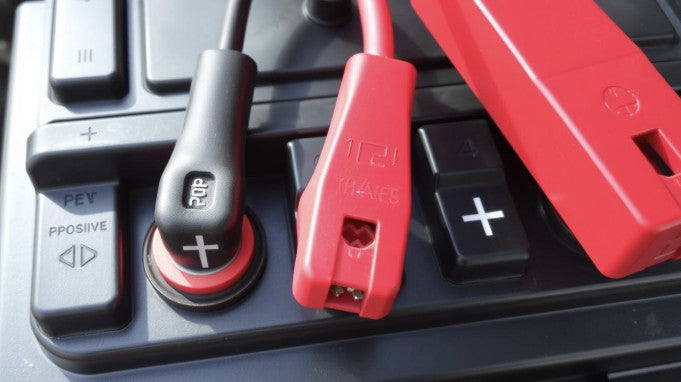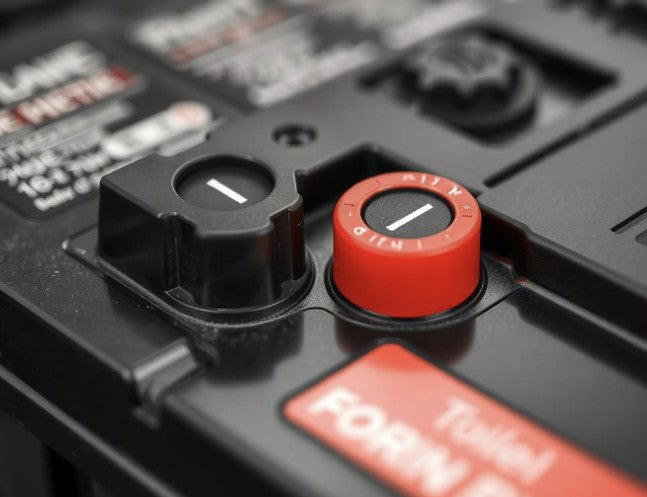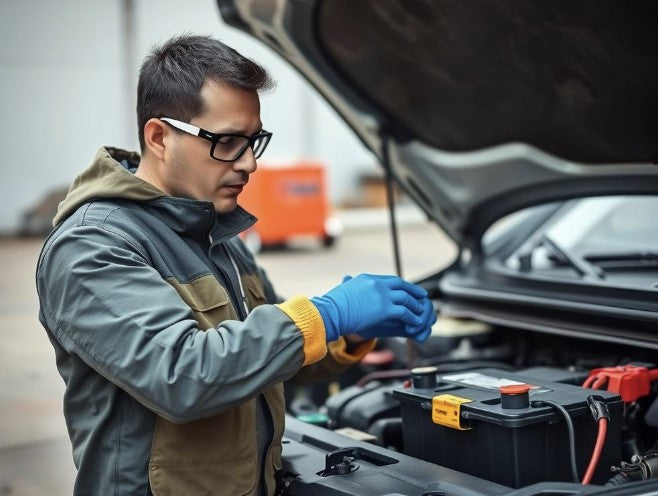Connecting battery terminals incorrectly is a common mistake that can have serious consequences for your vehicle or device. Whether you're jump-starting a car, replacing a battery, or working with household electronics, reversing the positive and negative connections can lead to immediate damage or create hidden problems that emerge later. This comprehensive guide explains what happens when you connect battery terminals wrong, how to identify and fix the issue, and most importantly, how to prevent this costly mistake.
Immediate Consequences of Reversed Battery Connections
When you connect battery terminals wrong, several things can happen immediately. Understanding these consequences can help you recognize the problem quickly and take appropriate action.
Sparks, Smoke, and Heat
The most immediate sign of reversed battery terminals is often sparking, smoke, or excessive heat. This happens because you've created a direct short circuit across the battery. The cables and battery terminals may become extremely hot within seconds, potentially melting insulation or causing burns if touched.
Warning: If you notice sparks, smoke, or excessive heat when connecting a battery, disconnect immediately to prevent further damage or injury.
Battery Damage
Connecting battery terminals wrong can cause immediate internal damage to the battery itself. The reverse polarity creates abnormal chemical reactions inside the battery, potentially causing it to swell, leak corrosive acid, or in extreme cases, explode. Even if the battery appears undamaged externally, its capacity and lifespan may be significantly reduced.
Electrical System Damage from Wrong Terminal Connections
Beyond the battery itself, connecting terminals wrong can cause extensive damage to your vehicle's electrical system or electronic device. These damages may not be immediately apparent but can lead to costly repairs.
Blown Fuses
Fuses are designed to protect electrical circuits by breaking the connection when too much current flows through them. When you connect battery terminals wrong, the sudden surge of current often blows multiple fuses throughout the electrical system. While replacing fuses is relatively inexpensive, locating all the blown fuses can be challenging.
Alternator Damage
The alternator is particularly vulnerable to damage from reversed battery connections. When battery terminals are connected wrong, the diodes in the alternator can instantly burn out. This happens because the diodes are designed to allow current to flow in only one direction. Reversed polarity forces current in the opposite direction, destroying these components.
A damaged alternator will fail to charge your battery properly, leading to repeated battery drain and starting problems. Replacing an alternator is a significant expense, often costing hundreds of dollars in parts and labor.
ECU and Electronic Component Damage
Modern vehicles and devices rely heavily on electronic control units (ECUs) and sensitive electronic components. These components are designed to operate with specific voltage and polarity. When you connect battery terminals wrong, the reversed polarity can instantly damage these expensive components.
Symptoms of ECU damage include check engine lights, erratic electrical behavior, failure of electronic systems like power windows or radio, and in severe cases, the vehicle may not start at all. Replacing an ECU can cost anywhere from $500 to several thousand dollars depending on the vehicle.
Fire and Explosion Risks
Perhaps the most serious consequence of connecting battery terminals wrong is the risk of fire or explosion. Batteries contain flammable hydrogen gas that can ignite from sparks created during incorrect connections.
Danger: Battery explosions can cause serious injuries including chemical burns, eye injuries from acid splatter, and trauma from explosion fragments. Always wear eye protection when working with batteries.
The risk of fire extends beyond the battery itself. Damaged wiring with melted insulation can create short circuits elsewhere in the vehicle, potentially causing fires even after the initial connection mistake has been corrected.
Safety Tips for Handling Battery Connections
Preventing incorrect battery connections is much easier than dealing with the consequences. Follow these essential safety tips whenever working with batteries.
Proper Connection Order
When disconnecting: Always remove the negative (black/−) terminal first, then the positive (red/+) terminal.
When connecting: Always connect the positive (red/+) terminal first, then the negative (black/−) terminal.
Jump starting: Connect positive to positive, negative to engine block or chassis (not the negative terminal of the dead battery).
Essential Safety Equipment
Safety glasses to protect against acid splashes or sparks
Insulated gloves to prevent electrical shocks
Insulated tools with rubber-coated handles
Battery terminal pullers for safe terminal removal
Terminal cleaning tools to ensure good connections
Prevent Battery Connection Mistakes
Download our free Battery Connection Safety Checklist to keep in your garage or vehicle. This printable guide ensures you'll never connect battery terminals wrong again.
How to Identify Battery Terminals Correctly
Correctly identifying battery terminals is crucial to prevent connection mistakes. Here's how to be certain you're connecting to the right terminals:
Look for markings: Batteries have "+" and "−" symbols stamped near the terminals.
Color coding: Positive terminals often have red covers or markings, while negative terminals have black.
Terminal size: On many batteries, the positive terminal is slightly larger in diameter than the negative terminal.
Use a voltmeter: If unsure, use a digital voltmeter to confirm polarity before connecting.
Check the manual: Your vehicle's owner manual will show the correct terminal locations.
What to Do If You've Connected Battery Terminals Wrong
If you realize you've connected battery terminals wrong, taking immediate action can minimize damage. Follow these steps:
Disconnect immediately: Remove the connections as quickly as possible, starting with the negative terminal.
Check for visible damage: Look for melted cables, swollen battery, or other obvious signs of damage.
Test the battery: If possible, use a multimeter to check if the battery still holds a charge.
Check fuses: Inspect all fuses in the vehicle's fuse boxes and replace any that are blown.
Test electrical systems: Turn on lights, radio, and other electrical components to check for functionality.
Monitor charging system: After restarting, check if the battery warning light stays on, indicating alternator problems.
Seek professional help: If you notice any abnormal behavior, have the vehicle inspected by a qualified technician.
Emergency Battery Connection Guide
Download our step-by-step guide on what to do after connecting battery terminals wrong. This guide could save you hundreds in repair costs.
Frequently Asked Questions About Wrong Battery Connections
Can reversed terminals drain a battery?
Yes, connecting battery terminals wrong creates a direct short circuit that rapidly drains the battery. This extreme discharge not only depletes the battery but can permanently damage its internal structure, reducing its capacity and lifespan even if it appears to work afterward.
How to identify correct terminal polarity?
You can identify correct terminal polarity through several methods:
- Look for "+" and "−" symbols stamped on the battery
- Check for color coding (red for positive, black for negative)
- Measure with a voltmeter (positive lead to positive terminal should show positive voltage)
- Consult your vehicle's owner manual for the specific battery layout
Does insurance cover reversed battery damage?
Most standard auto insurance policies do not cover damage caused by connecting battery terminals wrong, as this is considered operator error or improper maintenance rather than an accident. Some comprehensive policies might cover resulting damage like fires, but the initial electrical damage is typically excluded. Check with your specific insurance provider to understand your coverage.
Can a car recover from reversed polarity?
Whether a car can recover from reversed polarity depends on how quickly the incorrect connection was removed and the extent of the damage. Modern vehicles have some protective measures like fuses that may prevent catastrophic damage. However, sensitive electronic components may still be damaged. If the vehicle starts and runs normally after the incident, continue to monitor for unusual behavior in the electrical system.
How long does it take to damage a car with reversed battery connections?
Damage from connecting battery terminals wrong can occur almost instantly. Sensitive electronic components can be damaged in milliseconds, while other components like the alternator diodes may fail within seconds. The longer the incorrect connection remains, the more extensive the damage will be. This is why immediate disconnection is crucial if you realize you've made a connection mistake.
Tools and Products to Prevent Battery Connection Mistakes
Color-Coded Terminal Covers
These protective covers clearly identify positive and negative terminals, preventing accidental reversal during connection.
Battery Connection Indicators
These devices provide visual or audible warnings if you attempt to connect terminals incorrectly.
Insulated Battery Tools
Specially designed tools with insulated handles prevent shorts and make battery maintenance safer.
Protect Your Vehicle's Electrical System
Learn about the best tools and practices to prevent battery connection mistakes with our comprehensive guide.
Special Cases: Motorcycles and Household Devices
Motorcycle Batteries
Motorcycle batteries are particularly sensitive to incorrect connections due to their smaller size and capacity. The confined spaces in motorcycles also increase the risk of accidental shorts. Always use a battery tender for motorcycles when not in use, and be especially careful with polarity when connecting.
Household Devices
Even small household devices can be damaged by reversed battery connections. While the safety risks are lower than with car batteries, connecting batteries wrong in electronics can still cause permanent damage to circuits and components. Always check the polarity markings in battery compartments before installation.
Protecting Your Vehicle from Battery Connection Mistakes
Connecting battery terminals wrong is a common mistake with potentially serious consequences. From blown fuses and damaged alternators to ECU failures and fire risks, the costs can quickly escalate. By understanding proper connection procedures, using the right tools, and taking immediate action if mistakes occur, you can protect your vehicle and ensure your safety.
Remember that prevention is always better than repair. Take the time to verify connections, use proper safety equipment, and follow correct procedures. If you're ever unsure about battery connections, consult your vehicle's manual or seek professional assistance rather than risking damage to your vehicle or injury to yourself.
Master Battery Safety and Maintenance
Download our complete battery safety guide to protect your vehicle and ensure proper maintenance. This comprehensive resource covers everything from connection procedures to long-term battery care.




Leave a comment
This site is protected by hCaptcha and the hCaptcha Privacy Policy and Terms of Service apply.